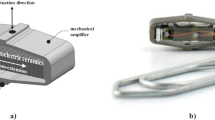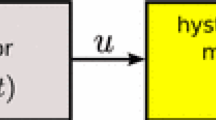Abstract
The modeling of the piezoelectric actuator is very important for the fast and accurate nano-positioning control. However, the complex creep, vibration and hysteresis dynamics make the modeling very difficult. Because there are often model uncertainties in the first-principle model, the model identification from the experimental data is very necessary. Most identification approaches only consider partial dynamics of the creep, vibration and hysteresis. Though they can be combined together after they are individually identified from different experiments, it is difficult to design the completely decoupled experiment. In this study, an incremental Hammerstein-like modeling approach is proposed to identify the creep, vibration and hysteresis dynamics from one experiment. The model is called nonlinear–linear–linear-Hammerstein-like model, where one dynamic nonlinear system is used to model the hysteresis and two dynamic linear systems are used to model the creep and vibration. The creep and vibration are assumed to be decoupled, and there is a known upper bound on the order of the creep model. A two-stage incremental modeling approach is proposed to reduce the modeling complexity, where the slow dynamics of the hysteresis and creep are estimated first and then the residual of this model is used to estimate the fast dynamics of the vibration. In each stage, the model structure and order are determined by a locally regularized orthogonal least-squares-based model term selection algorithm and the parameters are estimated using a regularized least-squares method. The effectiveness of the proposed modeling approach is verified by the simulations and experiments on typical piezoelectric actuators.
































Similar content being viewed by others
References
Peng, J.Y., Chen, X.B.: A survey of modeling and control of piezoelectric actuators. Mod. Mech. Eng. 3, 1–20 (2013)
Rakotondrabe, M., Clévy, C., Lutz, P.: Complete open loop control of hysteretic, creeped, and oscillating piezoelectric cantilevers. IEEE Trans. Autom. Sci. Eng. 7(3), 440–450 (2010)
Peng, J.Y., Chen, X.B.: Integrated PID-based sliding mode state estimation and control for piezoelectric actuators. IEEE/ASME Trans. Mechatron. 19(1), 88–99 (2014)
Liaw, H.C., Shirinzadeh, B., Smith, J.: Robust neural network motion tracking control of piezoelectric actuation systems for micro/nanomanipulation. IEEE Trans. Neural Netw. 20(2), 356–367 (2009)
Islam, M.N., Seethaler, R.J.: Sensorless position control for piezoelectric actuators using a hybrid position observer. IEEE/ASME Trans. Mechatron. 19(2), 667–675 (2014)
Devasia, S., Eleftheriou, E., Moheimani, S.O.R.: A survey of control issues in nanopositioning. IEEE Trans. Control Syst. Technol. 15(5), 802–823 (2007)
Adriaens, H.J.M.T.A., de Koning, W.L., Banning, R.: Modeling piezoelectric actuators. IEEE/ASME Trans. Mechatron. 5(4), 331–341 (2000)
Chen, C.J.: Electromechanical deflections of piezoelectric tubes with quartered electrodes. Appl. Phys. Lett. 60(1), 132–134 (1992)
Sebastian, A., Salapaka, S.M.: Design methodologies for robust nano-positioning. IEEE Trans. Control Syst. Technol. 13(6), 868–876 (2005)
Yong, Y.K., Aphale, S.S., Moheimani, S.O.R.: Design, identification, and control of a flexure-based XY stage for fast nanoscale positioning. IEEE Trans. Nanotechnol. 8(1), 46–54 (2009)
Schitter, G., Stemmer, A.: Identification and open-loop tracking control of a piezoelectric tube, scanner for high-speed scanning-probe microscopy. IEEE Trans. Control Syst. Technol. 12(3), 449–454 (2004)
Schitter, G., Astrom, K.J., DeMartini, B.E., et al.: Design and modeling of a high-speed AFM-scanner. IEEE Trans. Control Syst. Technol. 15(5), 906–915 (2007)
Ji, H.-W., Yang, S.-X., Wu, Z.-T., Yan, G.-B.: Precision control of piezoelectric actuator using support vector regression nonlinear model and neural networks. In: Proceedings of the Fourth International Conference on Machine Learning and Cybernetics, Guangzhou, China, pp. 1186–1191 (2005)
Croft, D., Shed, G., Devasia, S.: Creep, hysteresis, and vibration compensation for piezoactuators: Atomic force microscopy application. J. Dyn. Syst. Meas. Control Trans. ASME 123(1), 35–43 (2001)
Jung, H., Shim, J.Y., Gweon, D.: Tracking control of piezoelectric actuators. Nanotechnology 12, 14–20 (2001)
Liu, Y.F., Shan, J.J., Gabbert, U., Qi, N.M.: Hysteresis and creep modeling and compensation for a piezoelectric actuator using a fractional-order Maxwell resistive capacitor approach. Smart Mater. Struct. 22, 115020 (2013)
Croft, D., Devasia, S.: Vibration compensation for high speed scanning tunneling microscopy. Rev. Sci. Instrum. 70(12), 4600–4605 (1999)
Croft, D., Devasia, S.: Hysteresis and vibration compensation for piezoactuators. J. Guid. Control Dyn. 21(5), 710–717 (1998)
Ge, P., Jouaneh, M.: Tracking control of a piezoceramic actuator. IEEE Trans. Control Syst. Technol. 4(3), 209–216 (1996)
Mrad, R.B., Hu, H.: A model for voltage to displacement dynamics in piezoceramic actuators subject to dynamic voltage excitations. IEEE/ASME Trans. Mechatron. 7(4), 479–489 (2002)
Bashash, S., Jalili, N.: Underlying memory-dominant nature of hysteresis in piezoelectric materials. J. Appl. Phys. 100(1), 1–6 (2006)
Yeh, T.J., Lu, S.W., Wu, T.Y.: Modeling and identification of hysteresis in piezoelectric actuators. J. Dyn. Syst. Meas. Control Trans. ASME 128, 189–196 (2006)
Janaideh, M.A., Rakheja, S., Su, C.Y.: An analytical generalized Prandtl-Ishlinskii model inversion for hysteresis compensation in micropositioning control. IEEE/ASME Trans. Mechatron. 16(4), 734–744 (2011)
Ji, D.H., Koo, J.H., Yoo, W.J., Park, J.H.: Precise tracking control of piezoelectric actuators based on a hysteresis observer. Nonlinear Dyn. 70, 1969–1976 (2012)
Rochdi, Y., Giri, F., Ikhouane, F., Chaoui, F.Z., Rodellar, J.: Parametric identification of nonlinear hysteretic systems. Nonlinear Dyn. 58, 393–404 (2009)
Jiang, H., Ji, H., Qiu, J., Chen, Y.: A modified Prandtl-Ishlinskii model for modeling asymmetric hysteresis of piezoelectric actuators. IEEE Trans. Ultrason. Ferroelectr. Freq. Control 57(5), 1200–1210 (2010)
Qin, H., Bu, N., Chen, W., Yin, Z.: An asymmetric hysteresis model and parameter identification method for piezoelectric actuator. Math. Probl. Eng. 2014 (2014). doi:10.1155/2014/932974
Ku, S.S., Pinsopon, U., Cetinkunt, S., Nakajima, S.: Design, fabrication, and real-time neural network control of a three-degrees-of freedom nanopositioner. IEEE/ASME Trans. Mechatron. 5(3), 273–280 (2000)
Jiles, D., Thoelke, J.: Theory of ferromagnetic hysteresis determination of model parameters from experimental hysteresis loops. IEEE Trans. Magn. 25(5), 3928–3930 (1989)
Dirscherl, K., Garnæs, J., Nielsen, L.: Modeling the hysteresis of a scanning probe microscope. J. Vac. Sci. Technol. B 18(2), 621–625 (2000)
Ang, W.T., Khosla, P.K., Riviere, C.N.: Feedforward controller with inverse rate-dependent model for piezoelectric actuators in trajectory-tracking applications. IEEE/ASME Trans. Mechatron. 12(2), 134–142 (2007)
Xiao, S., Li, Y.: Dynamic compensation and H\(\infty \) control for piezoelectric actuators based on the inverse Bouc–Wen model. Robot. Comput. Integr. Manuf. 30, 47–54 (2014)
Deng, L., Tan, Y.: Diagonal recurrent neural network with modified backlash operators for modeling of rate-dependent hysteresis in piezoelectric actuators. Sens. Actuators A Phys. 148(1), 259–270 (2008)
Zhang, X., Tan, Y.: A hybrid model for rate-dependent hysteresis in piezoelectric actuators. Sens. Actuators A Phys. 157, 54–60 (2010)
Xu, Q., Wong, P.K.: Hysteresis modeling and compensation of a piezostage using least squares support vector machines. Mechatronics 21(7), 1239–1251 (2011)
Li, P.Z., Yan, F., Ge, C., Wang, X.L., Xu, L.S., Guo, J.J., Li, P.Y.: A simple fuzzy system for modelling of both rate-independent and rate-dependent hysteresis in piezoelectric actuators. Mech. Syst. Signal Process. 36, 182–192 (2013)
Gu, G., Zhu, L.: Modeling of rate-dependent hysteresis in piezoelectric actuators using a family of ellipses. Sens. Actuators A Phys. 165, 303–309 (2011)
Stoica, P., Söderström, T.: Instrumental-variable methods for identification of Hammerstein systems. Int. J. Control 35(3), 459–476 (1982)
Bai, E.W., Li, D.: Convergence of the iterative Hammerstein system identification algorithm. IEEE Trans. Autom. Control 49(11), 1929–1940 (2004)
Hsu, J.T., Ngo, K.D.T.: A Hammerstein-based dynamic model for hysteresis phenomenon. IEEE Trans. Power Electron. 12(3), 406–413 (1997)
Hsu, J.T., Ngo, K.D.T.: Subcircuit modeling of magnetic cores with hysteresis in pspice. IEEE Trans. Aerosp. Electron. Syst. 38(4), 1425–1434 (2002)
Wang, Z., Zhang, Z., Mao, J., Zhou, K.: A Hammerstein-based model for rate-dependent hysteresis in piezoelectric actuator. In: 2012 24th Chinese Control and Decision Conference (CCDC), Taiyuan, China, 23–25 May, 2012
Mokaberi, B., Requicha, A.A.G.: Compensation of scanner creep and hysteresis for AFM nanomanipulation. IEEE Trans. Autom. Sci. Eng. 5(2), 197–206 (2008)
Wu, Y., Zou, Q. Z.: Iterative control approach to compensate for the hysteresis and the vibrational dynamics effects of piezo actuators. In: Proceedings of the 2006 American Control Conference, Minneapolis, Minnesota, USA, June 14–16, 2006, pp. 424–429
Liu, L., Tan, K.K., Teo, C.S., Chen, S.L., Lee, T.H.: Development of an approach towards comprehensive identification of hysteretic dynamics in piezoelectric actuators. IEEE Trans. Control Syst. Technol. 21(5), 1–12 (2013)
Leang, K.K., Zou, Q., Devasia, S.: Feedforward control of piezoactuators in atomic force microscope systems. IEEE Control Syst. Mag. 29(1), 70–82 (2009)
Giri, F., Rochdi, Y., Chaoui, F.Z., Brouri, A.: Identification of Hammerstein systems in presence of hysteresis-backlash and hysteresis-relay nonlinearities. Automatica 44(3), 767–775 (2008)
Qi, C.K., Li, H.-X.: A time/space separation based Hammerstein modeling approach for nonlinear distributed parameter processes. Comput. Chem. Eng. 33(7), 1247–1260 (2009)
Qi, C.K., Li, H.-X., Zhao, X.C., Li, S.Y., Gao, F.: Hammerstein modeling with structure identification for multi-input multi-output nonlinear industrial processes. Ind. Eng. Chem. Res. 50(19), 11153–11169 (2011)
Chen, S.: Local regularization assisted orthogonal least squares regression. Neurocomputing 69, 559–585 (2006)
MacKay, D.J.C.: Bayesian interpolation. Neural Comput. 4(3), 415–447 (1992)
Hong, X., Harris, C.J., Chen, S., Sharkey, P.M.: Robust nonlinear model identification methods using forward regression. IEEE Trans. Syst. Man Cybern. Part A Syst. Hum. 33(4), 514–523 (2003)
Ljung, L.: System Identification: Theory for the User, 2nd edn. Prentice-Hall, Englewood Cliffs (1999)
Hong, X., Mitchell, R.J., Chen, S., Harris, C.J., Li, K., Irwin, G.W.: Model selection approaches for non-linear system identification: a review. Int. J. Syst. Sci. 39(10), 925–946 (2008)
Bai, E.W.: An optimal two-stage identification algorithm for Hammerstein–Wiener nonlinear systems. Automatica 34(3), 333–338 (1998)
Gómez, J.C., Baeyens, E.: Identification of block-oriented nonlinear systems using orthonormal bases. J. Process Control 14(6), 685–697 (2004)
Acknowledgments
The authors would like to thank the associate editor and anonymous referees for their valuable comments and suggestions. The work is partially supported by grants from National Basic Research Program 973 of China (Grant Nos. 2013CB035501 and 2013CB035504), National Natural Science Foundation of China (Grant Nos. 61473187, 61004047, 51175323) and Shanghai Natural Science Foundation (Grant No. 14ZR1422600).
Author information
Authors and Affiliations
Corresponding author
Appendix
Appendix
Theorem 1
[56] Let \(\hat{{\Theta }}\in R^{n_{bcs} \times n_{fs} }\) have rank \(\rho \ge 1\), and let the economy-size SVD of \(\hat{{\Theta }}\) be given by
where the singular matrix \(\varvec{\Sigma }_\rho =\hbox {diag}\{\sigma _i \}\) such that
and where the matrices \(\mathbf{U}_\rho =[\varvec{\mu }_1 ,\ldots ,\varvec{\mu }_\rho ]\in R^{n_{bcs} \times \rho }\) and \(\mathbf{V}_\rho =[\varvec{\upsilon }_1 ,\ldots ,\varvec{\upsilon }_\rho ]\in R^{n_{fs} \times \rho }\) contain only the first \(\rho \) columns of the unitary matrices \(\mathbf{U}\in R^{n_{bcs} \times n_{bcs} }\) and \(\mathbf{V}\in R^{n_{fs} \times n_{fs} }\) provided by the full SVD of \(\hat{{\Theta }}\),
respectively. Then the vectors \(\mathbf{b}_{cs} \in R^{n_{bcs} \times 1}\) and \(\varvec{\uptheta }_{fs} \in R^{n_{fs} \times 1}\) that minimize the norm \(||\hat{{\Theta }}-\mathbf{b}_{cs} \varvec{\uptheta }_{fs}^\mathrm{T} ||_F^2 \), are given by [56]
where \(\mathbf{U}_1 \in R^{n_{bcs} \times 1}\), \(\mathbf{V}_1 \in R^{n_{fs} \times 1}\) and \({\varvec{\Sigma }}_1 =\hbox {diag}\{\sigma _1 \}\) are given by the following partition of the economy-size SVD in (92)
and the approximation error is given by
Rights and permissions
About this article
Cite this article
Qi, C., Gao, F., Li, HX. et al. An incremental Hammerstein-like modeling approach for the decoupled creep, vibration and hysteresis dynamics of piezoelectric actuator. Nonlinear Dyn 82, 2097–2118 (2015). https://doi.org/10.1007/s11071-015-2302-z
Received:
Accepted:
Published:
Issue Date:
DOI: https://doi.org/10.1007/s11071-015-2302-z




